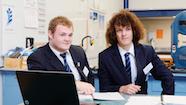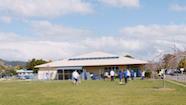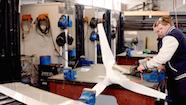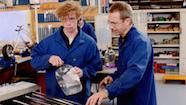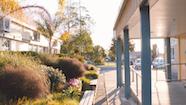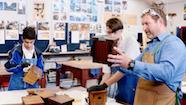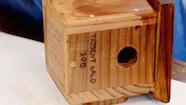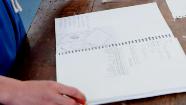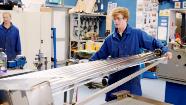Year 13 students explain their water powered turbine.
Renewable energy: A model micro-hydro system
Transcript
Briar: Our projects are micro-hydro so it’s a water-powered turbine and it creates electricity. We're using it as a teaching tool for our teacher because he is really into renewable energy and so each light bulb is going to use a different amount of power. And so we want to be able to showcase that.
Daniel: It all started off with Iain Charity donating his micro hydro up here. The high pressure mains line comes in through this pipe at the back and comes through a small orifice, a small hole. It shoots out a water jet, which shoots onto little cups [pelton wheel cups]. That spins the pelton wheel, which spins coils of copper. Outside there's a magnet that induces a current, that creates electricity that comes out to power our light bulbs and the vault meters.*
Briar: We can change the orifice size and we worked out the other day that the best orifice size was a six millimeter.
Daniel: With the six mil orifice, it is running at 1,620 revs per minute and at about 85 vaults. The object with that is to have an LED, with that top bulb over there, an LED [eco is the next one down], and then a halogen, and ...
Briar: ... and then an incandescent on the bottom. And so we're going from the top to the bottom. The reason why the LED is up the top is because that's the one that uses the least amount of electricity to run compared to the incandescent, which is down the bottom.
Daniel: We’re connecting these up to the switch so we can select the switch and show the brightness of each separate bulb.
Briar: And then if you've got a house that’s got multiple different types of light bulbs in it, you can turn them all on and show how much electricity that's going to use.
Daniel: There is a lot of water wastage with this.
Briar: That's why we wanted to put in a reservoir so that we could catch some of it and then reuse it for washing hands. First, we took it apart to look at what we were doing and what we were working with. Then we moved onto frame design after we figured out where we wanted to install it because we had to have special specifications. We had to have a certain amount of room to add new gages and to support the micro-hydro.
Daniel: And then we had to go in the room that's behind here and look at all of the mains copper pipes to see if we could connect this up to the mains through the wall. We made plans on how we were going to set up the electrical box.
Briar: And do the plumbing.
Daniel: And made a schematic for the frame. It was mainly Mr.Dobin asking him what to do and him giving ideas and then us researching. We talked to Mr.Dobin about the components we had to get in the box and he suggested Scott Christie, which is the school's electrician. So he organised all of the vault meters and the switches and the east opp and gave us a price. We got all of the components through him. Don Meades came in. He's a retired electrician and he showed us all of the electrical methods to put in the wires from the micro-hydro into the box, how to bend all of the electrical conduit and how to connect the vault meters and that up.
Briar: We’ve worked really well together as a team, we kind of get along quite well.
Daniel: We don’t have that much knowledge of the electrical components and that, so we have been researching together and communicating.
Briar: Yeah and learning while we are trying to install it.
Daniel: I really like hands on stuff and this is the only subject I can really do that in.
Briar: Being in here is so amazing. It’s really a pleasure to be able to work all of this sort of stuff and learn different sorts of stuff that you wouldn't learn in a classroom.
Related videos
Renewable energy: Solar panels (03:46)
Students developed a brief for their project based on an authentic context.
Renewable energy: Solar panels for special education (04:30)
Year 13 students embraced an opportunity to work alongside the special education centre.
Renewable energy: Wind turbine (04:08)
A year 13 student and his teacher discuss their energy-saving project.
Renewable energy: Teaching programme (05:07)
Dave Dobbin inspires his year 13 students to learn about renewable energy.
Renewable energy: Principal and community support (04:35)
Input from the community helped this school project to grow.
Manufacturing nesting boxes: Halo project (04:35)
A great story prompted students to get behind a community project.
Values: Halo project (02:23)
Year 11 students deepened curriculum understandings through helping their community.
Key Competencies: Halo Project (02:44)
This technology project has rich links to the key competencies.
Renewable energy: Solar water heating (04:20)
Year 13 students discuss their solar water heating project.

